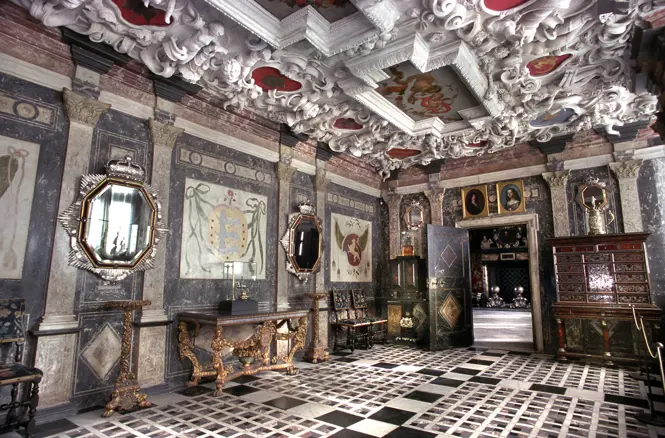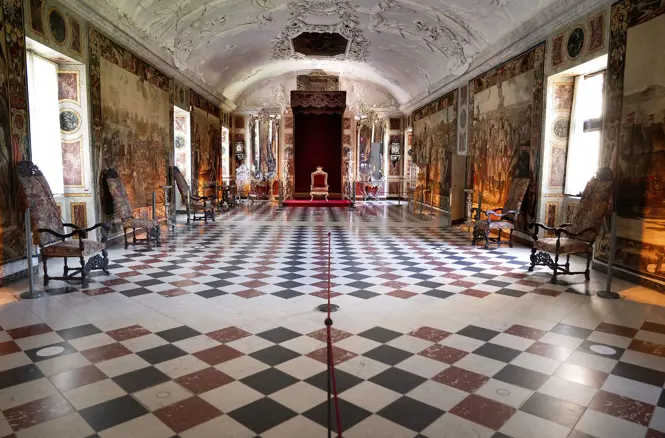
Through the 1700s, considerable art treasures were collected at Rosenborg Palace, among other things items from the estates of deceased royalty and from Christiansborg after the fire there in 1794.
Rosenborg Palace was built in the period 1606-34 as Christian IV’s summerhouse "in the country" just outside the ramparts of Copenhagen. Christian IV was very fond of the palace and often stayed at the castle when he resided in Copenhagen, and it was here that he died in 1648. After his death, the palace passed to his son Frederik III, who together with Queen Sophie Amalie carried out several types of modernisation. The last king who used the place as a residence was Frederik IV, and around 1720, Rosenborg was abandoned as residence in favor of Frederiksberg Palace.
Through the 1700s, considerable art treasures were collected at Rosenborg Palace, among other things items from the estates of deceased royalty and from Christiansborg Palace after the fire there in 1794. Soon the idea of a museum arose, and that was realised in 1833, which is The Royal Danish Collection’s official year of establishment.
The palace opened to the public in 1838, and there one could get a tour through the Royal Family’s history from the time of Christian IV up to the visitor’s own time. Along with the opening, there was a room set up with Frederik VI’s things, even though the king did not die until the following year. The chronological review and the furnished interiors, which even today are characteristic of Rosenborg Palace, were introduced here for the first time in European museum history.
The collection continued to grow, and in the 1960s, the initiative was taken to set up a section at Amalienborg for the newer part of the Royal House. This idea was realised in 1977, and the museum has been housed in rooms at Christian VIII’s Palace since 1994. The line of division between the two sections is set at 1863 so that Rosenborg Palace exhibits the Oldenborg kings and Amalienborg exhibits the Glücksborg monarchs.
In April 2012, a major restoration of the Marble Room concluded at the castle. The room is exceptional in the sense that other equally well-preserved spaces with the special artistic marbling cannot be found.
Objects at Rosenborg Palace with special connection to the Royal Danish House
Christian V’s crown from 1670 was used at the anointings (coronations) of all of the absolute monarchs, and the last anointing was in 1840. The crown is still used for the royal castrum doloris, which last occurred in 1972.
The crown jewels date back to the will of Christian VI’s Queen, Sophie Magdalene, from 1746. In it, she stipulated that her jewelry should not be passed on to a specific person but always be made available to the sitting queen at any time. The crown jewels have been added to several times and date in their current variety from 1840. The crown jewels consist primarily of four large sets of jewelry: two with brilliant-cut diamonds, one with emeralds and brilliant diamonds, and one with rubies, pearls and brilliant diamonds. Today, the crown jewels are also available to HM The Queen, who uses them once or several times a year, usually for the New Year’s levee, and in connection with state visits and other events in the Royal House.
The royal baptismal basin is of pure gold, and, since 1671, all of the royal children have been christened in this basin. Originally, the child’s name and christening date were inscribed on the back of the basin, but there was no space for additional names at the end of the 1700s. Belonging to the basin are a pitcher and two candlesticks, all of pure gold. At the christening, the basin is placed in a baptismal font of gilded silver. At the time of this writing, the font and basin were last used in May 2012 for HE Countess Athena's christening at Møgeltønder Church.
The palace also stores silver boxes with something as extraordinary as the remains of Frederik the III’s own placenta – called “caul” – as well as umbilical cords that belonged to the king’s eight children.

